LG OLED55E9 Review
LG OLED55E9 Review
LG's E9 is one of the more complete TV packages you'll see in 2019
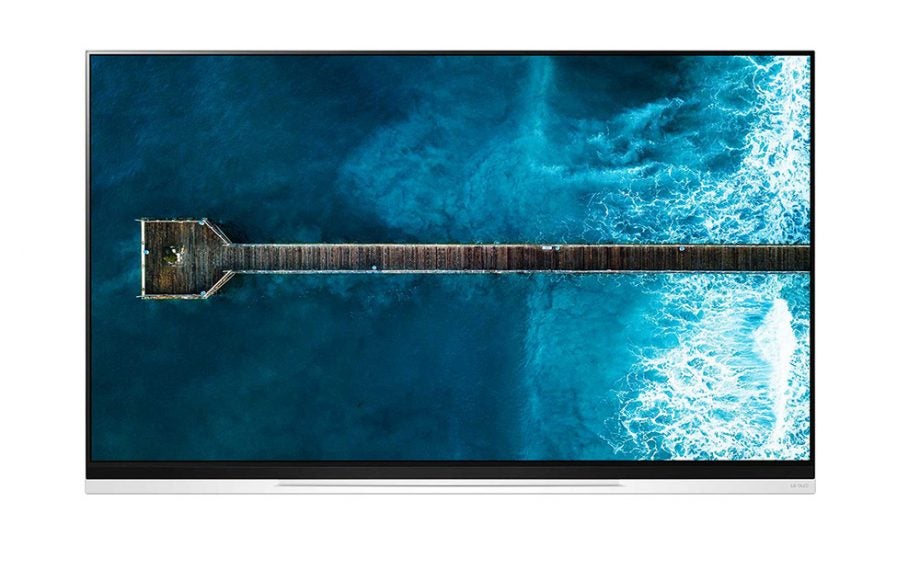
Verdict
A terrific OLED TV from LG: the E9 packs in plenty of features, excellent audio and delivers terrific picture quality across a range of content. While Samsung's QLEDs can go brighter, and LG's C9 is perhaps a better value proposition, the E9 offers an outstanding and (near) complete package
Pros
- Terrific image quality
- Comprehensive feature set
- webOS functionality
- Very good audio performance
- Low input lag
Cons
- No HDR10+
- Settings and modes can be a maze to navigate
Key Specifications
- Review Price: £2700
- HDR10, HLG & Dolby Vision
- 2nd-gen α9 Processor
- HDMI 2.1
- AI Sound
The LG E9 (OLED55E9) is the South Korean manufacturer’s premium OLED in its 2019 TV range, slotting in above the C9. It boasts the brand’s 2nd-gen α9 processor, AI smarts, Dolby Vision and voice-assistant support. With last year’s E8 knocked for its audio performance, LG is looking to improve matters with the E9
With its 2019 OLED TVs, LG not only has designs on delivering excellent picture quality, but it also wants to be at the centre of your living room experience. With the OLED55E9 (and OLED65E9), it’s nearly a case of what it can’t do.
Like the C9, it arrives with a wealth of features that will likely ensure you won’t ever want to leave the comfort of your sofa. But LG is up against stiff competition for the hearts and minds of TV buyers in this area of the market, with Samsung’s QLEDs making a strong case alongside OLED offerings from the likes of Panasonic, Philips and Sony.
With the E9, LG hasn’t felt compelled to reinvent the OLED wheel; “evolution” rather than “revolution” is the name of the game here. Can it stay on top then, or is it in danger of being surpassed by its rivals?
Related: Best 4K TVs
LG E9 design – A gorgeous-looking set with elegant, minimalist stylings
While 2018’s E8 bore a close resemblance to the C8, LG has taken a different route with the E9. There’s a more discernible difference between it and its C9 sibling.
While the LG E9 doesn’t reach W9 levels of flatscreen wonder, the glass-on-panel design employed here is elegant. The thin OLED screen, barely there bezel and brushed-metal finish give it a minimalist feel.
Related: LG OLED55C9 review

The TV’s rear panel juts out at the bottom, but not by much. While Samsung’s 2019 QLEDs are on the chunkier side, that isn’t an accusation you could level at the E9. Should you want to wall-mount it, the E9 supports it.
Front-firing speakers are located towards the bottom and the stand, as it is, is a combination of what appears to be a wafer-thin edge of curved glass and a counterweight on the rear.
Despite the 55-inch version weighing close to 26kg, assembly is simply a matter of sliding the screen into the stand’s grooves and tightening the five provided screws. And despite initial concerns that it could tip over, the weight of the counter-balance ensures it stays planted.
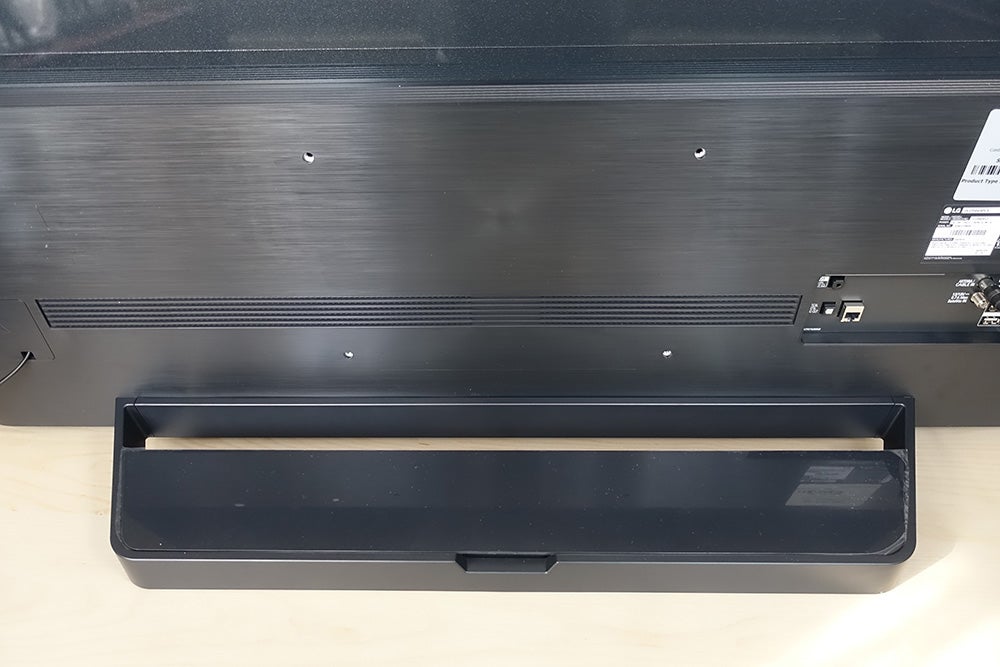
The Magic Remote remains unchanged. While the point-and-click nature of it can be fiddly, it becomes natural and intuitive to use within the confines of the webOS interface.
Video streaming aficionados should be sated by dedicated buttons for Netflix, Amazon Video and Rakuten (via the Movies button). For voice control, hold down the mic button and you’ll be able to utter your every whim at the screen.
Related: How to find 4K HDR content on Netflix and Amazon Prime Video
LG E9 features – An exhaustive set of features
“Comprehensive” would be a word to describe the LG E9’s features. In terms of what a TV can do, the E9 is like NASA’s Mission Control, your central hub from which you can control and monitor a wide range of devices from your settee.
Like the C9, LG has future-proofed its OLED TV range by adopting the HDMI 2.1 standard. The physical connections are housed on the rear and to the side, and you get 4 x HDMI 2.1 (the HDMI 2 port is eARC compatible), 3 x USB, LAN, CI slot, 2 x RF, an optical digital out, headphone out, Wi-Fi (802.11ac) and Bluetooth 5.
Related: What is Bluetooth 5?
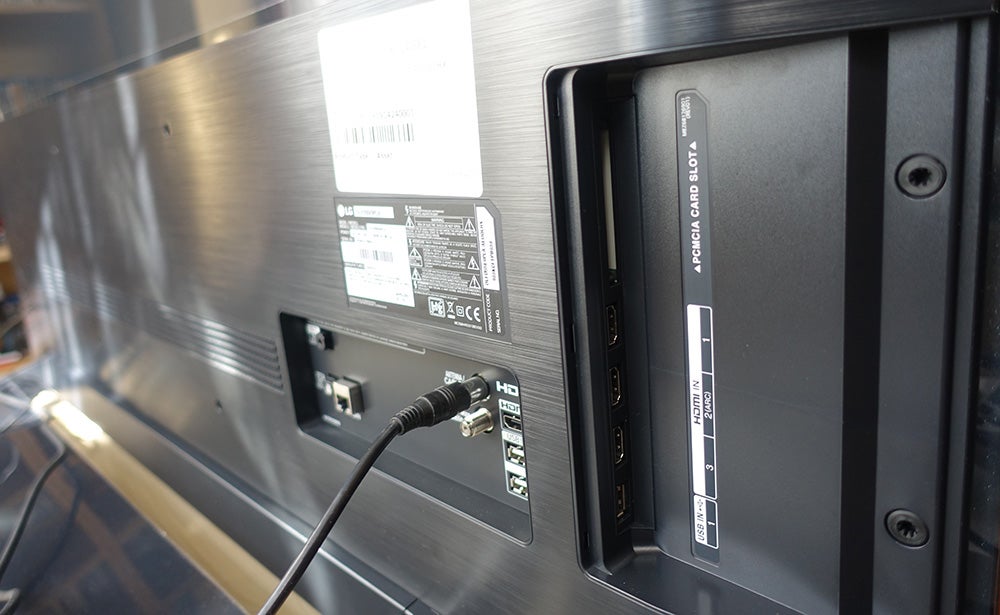
The presence of HDMI 2.1 also means ALLM (Auto Low Latency) and VRR (Variable Refresh Rate) are included for a smoother, less latent display. You’ll need both a compatible source and correct HDMI cable to take advantage, and right now the Xbox One X appears to be the only 2.1-compliant device.
The LG E9 scores 12.7ms for gaming lag, which is “blink and you’ll miss it” fast.
For those worried about burn-in, LG has sought to reduce its impact with the screen reverting to an animated screensaver mode following a few minutes of inactivity. There’s also a Gallery mode that works in a similar fashion to Samsung’s Ambient mode.
Related: What is HDMI 2.1?
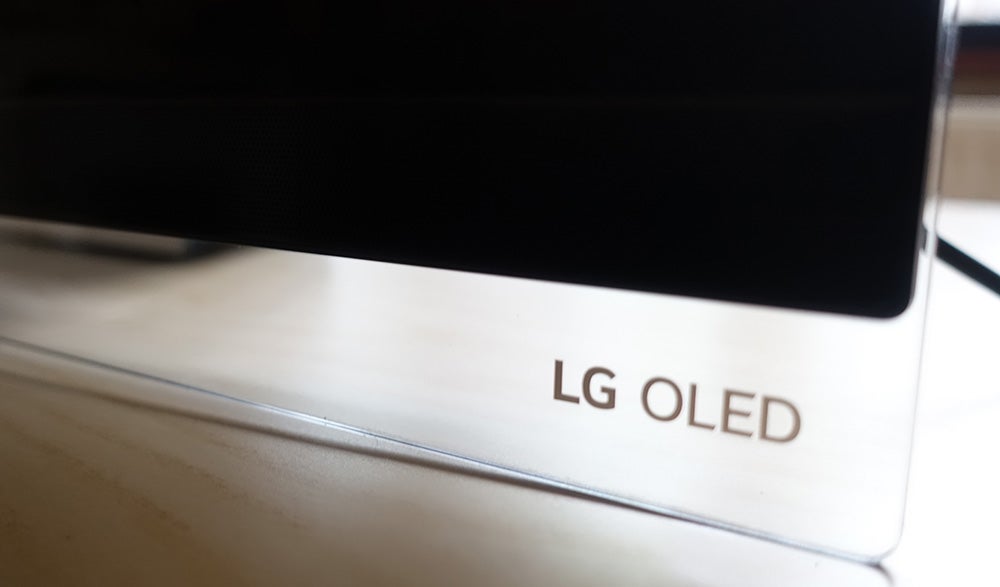
Like the C9, the E9 supports HDR10, HLG and Dolby Vision HDR. The lack of HDR10+ is an annoyance, especially since LG has been so forward-looking in other areas. The lack of HDR10+ content and playback devices likely played a part, although that hasn’t stopped Panasonic and Philips from including both HDR10+ and Dolby Vision on their sets.
I should also mention that the E9 is WiSA ready. WiSA stands for Wireless Speaker & Audio, and enables wireless connection to a WiSA-compatible speaker without the need for speaker cables or passthrough via an AV receiver. There aren’t many WiSA-enabled speakers available, yet the E9’s support for it is welcome, especially if the wireless speaker route opens up further down the line.
Related: Dolby Vision – everything you need to know
LG E9 interface – webOS remains a slick performer
WebOS returns and is still a slick smart offering. The improvements are mainly to do with Intelligent Edit and the Home Dashboard, as well as AI tricks in the guise of AI Preview, AI Recommendation and the ThinQ AI platform.
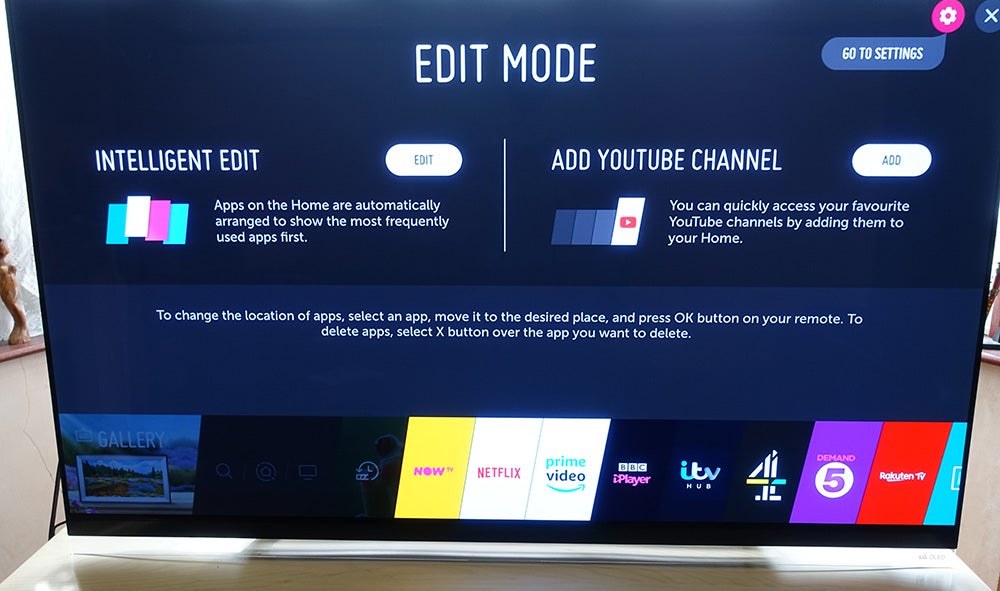
Intelligent Edit allows the user to reorganise the row of apps on the homescreen. Over time, apps will be listed according to how often you use them. For quicker access they can be swapped around; this can be done by clicking and holding on an app, entering Intelligent Edit mode, and then dragging and dropping the tiles. All the major on-demand and catch-up adds are supported, with Rakuten TV available in 4K.
Hover over an app and AI Preview is engaged, which offers a gander into that app’s content. Not all the apps offer this functionality, though, and personalised recommendations are available only if you sign in. Quick switching between apps is supported via the launcher, so you can bounce between apps without much of a delay.
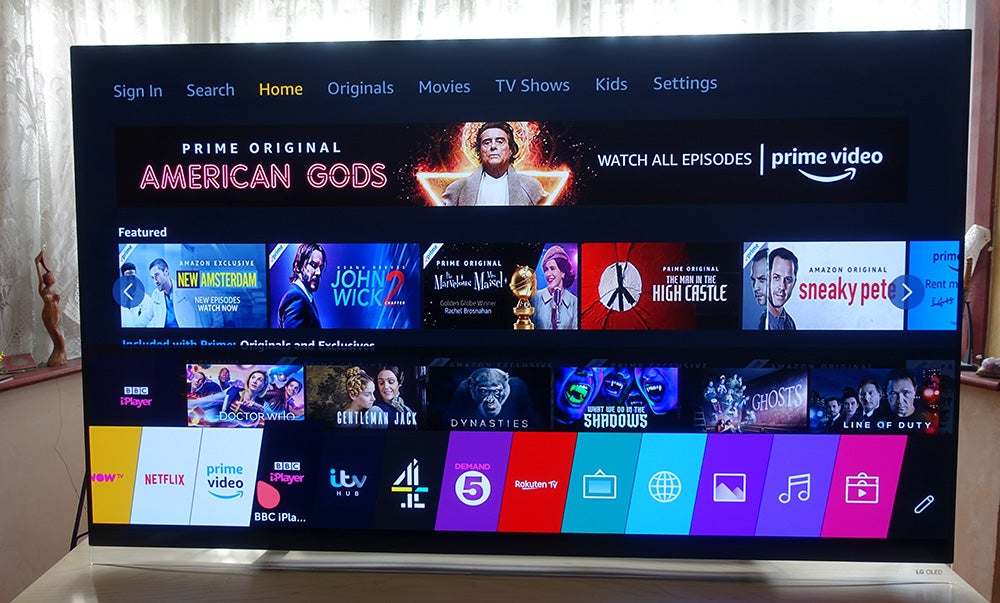
The Home Dashboard is the control hub for all inputs, outputs and IoT appliances. If your washing machine is “smart” then you can monitor its activity from here. Doubtless you’ll have more interesting things to do.
The Dashboard is also the place for managing Bluetooth devices, as well as AirPlay 2 and Apple HomeKit devices once that update rolls out.
AI Recommendation pertains to webOS monitoring your TV consumption (!), learning from your habits and suggesting new content to watch. If the pop-up messages become too annoying then they can be switched off, but they were few and far between during testing.
Related: What is AirPlay 2?
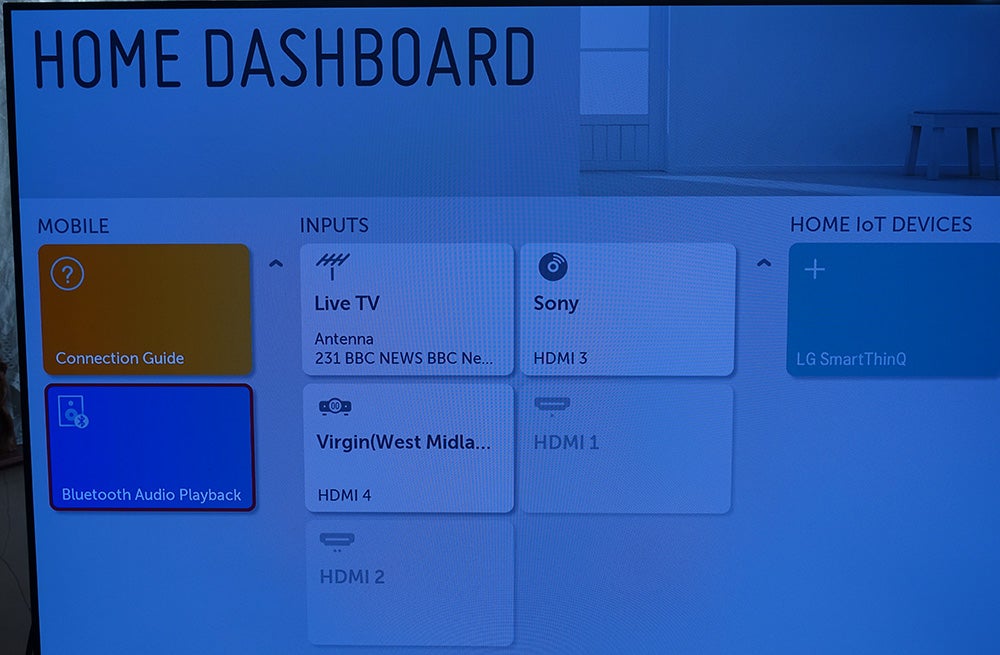
ThinQ AI underpins LG’s smart system, and this year it has brought Amazon Alexa voice control into the fold to sit alongside Google Assistant.
At the time of review the E9 didn’t have Alexa, but it has subsequently been updated, and access is granted by pressing and holding the Magic remote’s Prime Video button. Google Assistant is built-in and can field queries by holding the mic key.
You can ask the E9 to search for a programme, switch channels or HDMI inputs and so on, and voice control works well enough. Sometimes, it didn’t always understand what you asked of it. For example, “switch to HDMI 3” brought up the result “pictures of my 3” – not quite what I was looking for.
LG E9 picture quality – Spectacular images both with HDR and without
OLED panels are known for their deep blacks and excellent contrast, and the LG E9 is another great showcase. Picture quality is frequently outstanding, with great results from native 4K content and upscaled material.
There are several picture modes from which to choose and a multitude of settings to go with them. Just to confuse matters further, there’s Cinema and Cinema Home picture modes, while some modes have advanced settings (Dolby Vision) and others do not.
The TV boots up in Standard mode, which has a relatively cool colour temperature but affords an enjoyable picture out of the box. If you want colours to pop off the screen, Vivid is an option – although it does turn some content into an episode of children’s show Lazytown.
There’s Technicolour Expert mode, which is particularly good for films. Calibration is further supported through CaIMAN software and a built-in test pattern generator.
Related: OLED vs LED LCD – what’s the best display tech for you?

Starting off with a 4K Blu-ray of Blade Runner 2049 and the LG E9 brings out the film’s exquisite lighting and rich tones. Blacks look as slick as oil – although, arguably, they can be a little too strong. I’d suggest upping the brightness up a few notches to reveal a little more detail in the shadows. Otherwise, OLED’s ability of having bright parts sit next to dark has a gorgeous impact on scenes in 2049, with Roger Deakins cinematography exquisitely rendered.
It also offers a crisp sense of detail. Christopher Nolan’s Dunkirk looks sublime on an OLED screen, the detail of the IMAX-shot photography brought to the fore as you can detect most, if not all, the details on nuts, bolts and rivets in the Spitfire planes.
Related: Best 4K Blu-ray player

Step down to Freeview HD and it remains a colourful and bright image. It isn’t as sharp, but it’s still very much on the side of watchable, with bold colours and complexions rendered in a natural manner.
It’s worth noting that TruMotion, LG’s motion smoothing tech, is switched on automatically. For native 4K content it’s best to turn it off to avoid that glossy soap-opera sheen. For content under 4K, it depends on what you’re viewing. Watching Shrek 2 on BBC One HD appeared more filmic without it, although the judder become noticeable.
Related: What is 4K TV and Ultra HD?

Standard Definition (SD) content is predictably worse in terms of detail and colour accuracy. Nevertheless, it’s more than watchable. Faces can have a smooth, near-waxy feel at times, but the E9 does a fine job of upscaling and keeping everything relatively coherent and bright.
One issue spotted was an element of picture noise in Dunkirk. Strangely, it only emerged when watching one specific scene in the evening; it didn’t occur during the day, nor did it crop up on any other disc.
LG E9 sound quality – A surprisingly robust and expansive sound
Last year we panned the E8 for its disappointing audio, since it lacked “its predecessor’s direct, powerful, bass-rich and room-filling sound presence.” Suffice to say, the E9 puts in a good performance with regards to audio.
Standard mode is fine and hints at the presence of bass. AI Sound is more interesting and works by up-mixing two-channel audio to virtual 5.1. I wasn’t sold at first, but I think that’s more about how the content itself than the mode. AI Sound has more volume to it: bass – while not troubling a subwoofer – is better defined and the soundfield is bigger.
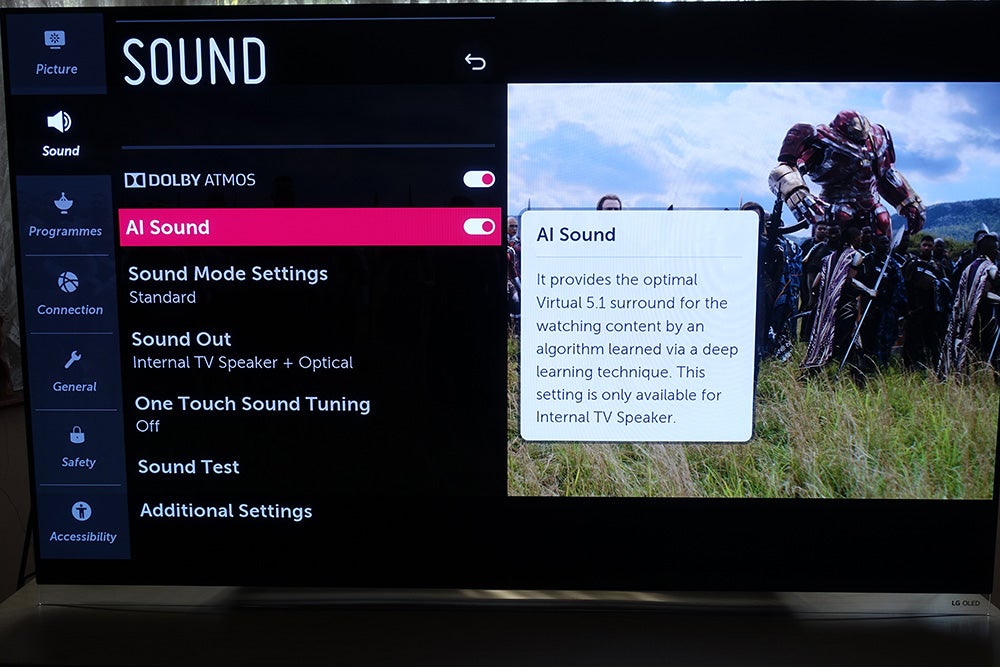
In a scene from Interstellar, where Cooper (Matthew McConaughey) and his family hunker down through a dust storm, the sheer volume and intensity of the sound was impressively cacophonous. AI Sound is also better at unearthing depth and detail at lower volumes, while the placement of sounds within the virtual 5.1 soundstage is well done. Dialogue is more acute and pronounced, too.
At times, there’s a stadium echo feel to some programmes and content just sounds better suited to Standard mode. Watching the second series of Westworld on Now TV and the presence of AI Sound over-complicated the sound mix.
Related: Best soundbar

The E9 also supports Atmos, and that expands the soundfield a touch wider. While the inclusion of Atmos and AI Sound isn’t the match of a multi-channel or bar/subwoofer combo, it does a surprisingly commendable job of opening up the soundstage and projecting the sound into the room.
Related: What is Dolby Atmos?
Why buy the LG E9?
The E9 is a terrific OLED TV. LG has managed to pack in a plethora of features, while also refining other aspects. The picture quality is outstanding across 4K, HD and SD, while the audio performance can be surprisingly hefty for such a slim TV.
The LG C9 is practically identical in terms of features and, arguably, offers better value as a result in light of its cheaper price. The biggest difference between the two is in terms of aesthetics, with the C9 also available in 77-in version – and I’m not sure that’s a big enough differentiator.
There’s also Samsung’s Q90R QLED to take into account, which is capable of better brightness and is closer to OLED’s contrast levels and viewing angles than in previous years. It doesn’t have Dolby Vision, though – and while the E9 lacks HDR10+ support, the amount of content on Dolby Vision arguably swings it to the LG.
If you want the best that OLED offers, great design, excellent audio and a comprehensive feature set, it’s hard to look past what LG has achieved with the E9.
How we test televisions
We test every TV we review thoroughly over an extended period of time. We use industry standard tests to compare features properly. We’ll always tell you what we find. We never, ever, accept money to review a product.


